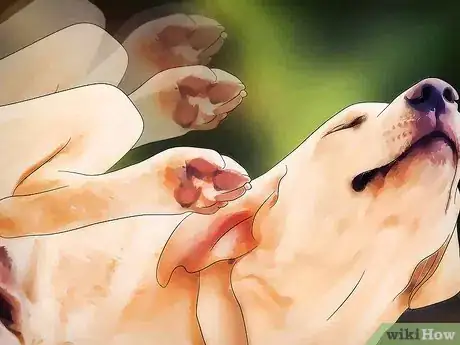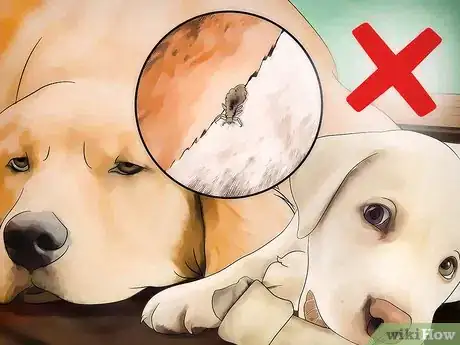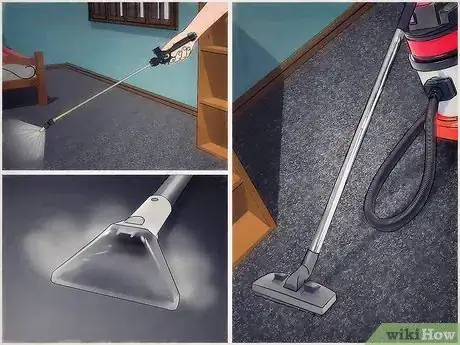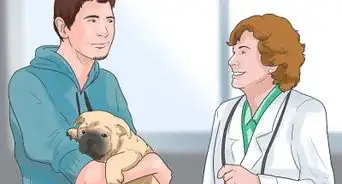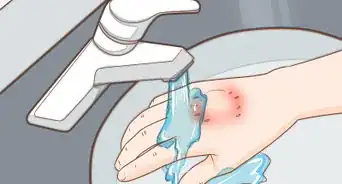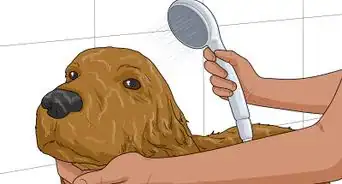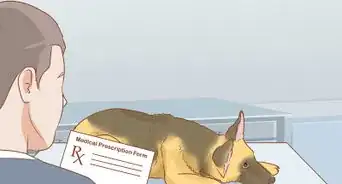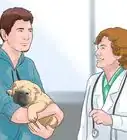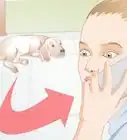This article was co-authored by David Schmucker. David Schmucker is a Dog Trainer and a Senior Trainer at Sidewalk Dog Training in Washington D.C. With over 17 years of experience, David specializes in canine training programs such as dog aggression training, dog behavioral correction, and dog separation anxiety training. David holds a BS in Personnel & Labor Management from the University of Maryland.
wikiHow marks an article as reader-approved once it receives enough positive feedback. In this case, several readers have written to tell us that this article was helpful to them, earning it our reader-approved status.
This article has been viewed 201,654 times.
No one wants their dog to have a parasitic infection, especially one such as lice. These tiny creatures live on the surface of the skin and lay their eggs on the dog's hair shafts. Lice infections on dogs are particularly unwelcome because they spread easily between dogs and make dogs very itchy. The good news is that lice infections on dogs are relatively easy to get rid of. You need to be persistent, treat all animals that have been in contact with an infected dog, and treat the environment where the dog resides.
Steps
Determining if Your Dog Has Lice
-
1Look for symptoms that your dog has lice. Lice cause itchiness, so you will probably first notice that your dog is scratching itself excessively. There will probably also be more than usual dandruff visible on the dog's coat.
- Lice do bite the dog and suck blood, so heavy infestations can also cause anemia.
-
2Learn what lice look like. Similar to human head lice, dog lice are small creatures that can barely be seen with the naked eye. They have six legs, each equipped with gripping claws, which enable the lice to cling tightly to hairs. Lice spend their entire life cycle on the pet.[1]
- Dogs can be infected by one of two kinds of lice, the common biting louse (Trichodectes canis) or the sucking louse (Linognathus setosus), which is less common. Treatment for both types is the same.
Advertisement -
3Look for lice in your dog's coat. Use a nit comb, a very fine-toothed comb, to look at the base you your dog's hair follicles right at the skin. The lice attach themselves to hair shafts and can be seen as tiny glistening dots. You may also see the nits or eggs, which the parasite glues onto the hair shafts and also look like tiny glistening specks.[3]
- These parasites are slow moving, so examination with a nit comb of the dog's coat will usually show up either the lice themselves or nits glued to the hair shafts, if your dog is actually infected.
Treating Lice
-
1Use a lice and nit comb to remove lice. This option depends on physically removing the lice using a comb with narrow teeth. The advantage is that it is chemical-free; however, it is extremely time consuming and labor intensive. This could be an option for a short-haired Chihuahua but is impractical for a Bernese Mountain dog.
- Lice and nit combs are best used as an aid to getting rid of lice, rather than a solo strategy.
- You need to be 100% certain you have combed the entire dog and gotten into all the nooks and crannies. It's very important to focus a lot of your attention on the armpits, groin, and ears. Lice also cling onto hair pretty tightly, so it's possible to comb the entire dog and not remove all the lice.
- Repeated daily combing is necessary for several weeks (around 4 - 6 weeks) in order to catch and remove nymphs as they hatch out from eggs.
- Kill the lice you have removed by immersing them in boiling water for a few minutes.
-
2Shampoo your dog with flea shampoo. Many flea shampoos containing pyrethroids or organophosphates are effective against lice when backed up with a nit comb directly after the bath. However, the treatment does not continue working once it is dry, and no shampoo can penetrate the eggs, so expect the next generation of lice to hatch out within 2 - 4 weeks. Thus regular weekly shampooing is required for at least 6 weeks.
- Follow the manufacturer's directions carefully. This is especially important with regard to how long the product needs to stay in contact with the skin before being thoroughly rinsed off. Not sticking to the recommended contact time can lead to lack of effectiveness.[3]
-
3Use insecticidal products. There are no parasitic products that are licensed to kill lice in dogs however several are known to be effective. These include products containing fipronil (Frontline, Effipro) Permethrin, Phosmet, fenthion, and selamectin (Revolution US, Advantage UK).[6]
- However, be aware that while most of these products have directions for monthly application when treating lice application every two weeks is advisable. This is because there is a drop-off in effectiveness after 2 weeks. Since no product can penetrate the tough louse egg, it is essential to keep the persistent level of active drug high enough to kill off the hatching nymph.[5]
-
4Treat all the dogs in the house. Lice are highly infectious to other dogs but can survive off of one dog alone. Whether you have one dog or many dogs, every dog needs the same treatment. Just assume that all the dogs in your home are infected to some degree and treat them all for lice with the same diligence. [6]
-
5Keep the dog quarantined. Because of the highly infectious nature of lice infections, the dog should not mix with other dogs (including at doggy daycare) while on treatment. In order to prevent spreading this nasty infection, quarantine your dog for a period of around 4 weeks after treatment.[7]
-
6Clean all items associated with the dog. For example, wash pet bedding on a hot cycle in the washing machine. Repeat this every time the dog has a treatment so that it goes back onto clean bedding and does not reinfect itself with contaminated bedding.
- Take special care to disinfect grooming utensils. These provide the perfect way for lice to spread between pets. Disinfect brushes and combs after use on one dog, by immersing them in boiling water and leaving for 10 minutes.[8]
-
7Treat your home. Adult lice are not particularly hardy and can be killed by steam cleaning. This is a good option for soft furnishings and carpet. Make sure to treat your dog's bed since the lice could have spread to it. However, the eggs or nits are hardier. You will need to wait for those to hatch out and then retreat with the steam cleaner in order to kill the more vulnerable adult stage.
- Alternatively, use an insecticidal environmental spray product such as Nuvan Staykill, Acclaim, or RIP Fleas, which are designed to kill fleas, larvae, and eggs. The advantage of these sprays is that they have a persistent action of several months, so the hatching eggs are killed with just one treatment. The disadvantage is that they are strong chemical products and not suitable for use in rooms where there are birds, reptiles, or fish, as they are toxic to these species and will cause death.[12]
-
8Repeatedly clean your home. It can be difficult to predict when lice eggs will hatch, so regular cleaning is the answer. The entire process of going from egg to adult takes between 2 - 4 weeks. With that in mind, a suggested minimal steam cleaning regime would be weekly for around 6 weeks, although there is no harm in treating more often (weekly) and for longer.
- Prevent future outbreaks by keeping a clean, sanitary home. Make sure the dog is kept in clean living conditions and is not overcrowded with other dogs. Lice thrive in dirty conditions with lots of dogs all kept in close confines, as they can then transfer between hosts easily.[13]
Expert Q&A
Did you know you can get expert answers for this article?
Unlock expert answers by supporting wikiHow
-
QuestionDo head lice jump like fleas?
 Pippa Elliott, MRCVSDr. Elliott, BVMS, MRCVS is a veterinarian with over 30 years of experience in veterinary surgery and companion animal practice. She graduated from the University of Glasgow in 1987 with a degree in veterinary medicine and surgery. She has worked at the same animal clinic in her hometown for over 20 years.
Pippa Elliott, MRCVSDr. Elliott, BVMS, MRCVS is a veterinarian with over 30 years of experience in veterinary surgery and companion animal practice. She graduated from the University of Glasgow in 1987 with a degree in veterinary medicine and surgery. She has worked at the same animal clinic in her hometown for over 20 years.
Veterinarian
-
QuestionHow do you remove a tick from a dog?
 Pippa Elliott, MRCVSDr. Elliott, BVMS, MRCVS is a veterinarian with over 30 years of experience in veterinary surgery and companion animal practice. She graduated from the University of Glasgow in 1987 with a degree in veterinary medicine and surgery. She has worked at the same animal clinic in her hometown for over 20 years.
Pippa Elliott, MRCVSDr. Elliott, BVMS, MRCVS is a veterinarian with over 30 years of experience in veterinary surgery and companion animal practice. She graduated from the University of Glasgow in 1987 with a degree in veterinary medicine and surgery. She has worked at the same animal clinic in her hometown for over 20 years.
Veterinarian
-
QuestionWhat causes dog lice?
 Pippa Elliott, MRCVSDr. Elliott, BVMS, MRCVS is a veterinarian with over 30 years of experience in veterinary surgery and companion animal practice. She graduated from the University of Glasgow in 1987 with a degree in veterinary medicine and surgery. She has worked at the same animal clinic in her hometown for over 20 years.
Pippa Elliott, MRCVSDr. Elliott, BVMS, MRCVS is a veterinarian with over 30 years of experience in veterinary surgery and companion animal practice. She graduated from the University of Glasgow in 1987 with a degree in veterinary medicine and surgery. She has worked at the same animal clinic in her hometown for over 20 years.
Veterinarian
References
- ↑ http://www.dogbreedinfo.com/articles/caninelice.htm
- ↑ Field Study on the insecticidal efficacy of Advantage against natural infestations of dogs with lice. Hanssen. Parasitol. Res. 85 (4)
- ↑ http://www.dogbreedinfo.com/articles/caninelice.htm
- ↑ Field Study on the insecticidal efficacy of Advantage against natural infestations of dogs with lice. Hanssen. Parasitol. Res. 85 (4)
- ↑ http://www.vet.bc.ca/lice.pml
- ↑ http://www.dogbreedinfo.com/articles/caninelice.htm
- ↑ http://www.vet.bc.ca/lice.pml
- ↑ http://www.vet.bc.ca/lice.pml
- ↑ Field Study on the insecticidal efficacy of Advantage against natural infestations of dogs with lice. Hanssen. Parasitol. Res. 85 (4)
- ↑ Field Study on the insecticidal efficacy of Advantage against natural infestations of dogs with lice. Hanssen. Parasitol. Res. 85 (4)
About This Article
If you've noticed your dog has lice, try shampooing your dog with flea shampoo and combing it with a nit comb afterwards. Alternatively, consider using insecticidal products like Revolution in the US or Advantage in the UK, but bear in mind that they need to be applied every 2 weeks. Regardless of the option you choose, be sure to treat all of your dogs as lice are highly infectious. For the same reason, keep dogs infected with lice quarantined for 4 weeks after treatment, and clean your home regularly to remove lice from household surfaces. To learn more from our Veterinarian co-author about the symptoms of dog lice, keep reading the article!
